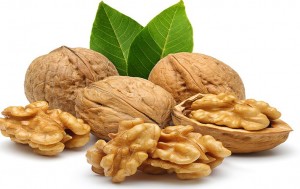Walnüsse sind essbare Kerne erhalten von Baum zu der Familie Juglandaceae gehören, in der Gattung, Juglans. Die Nüsse haben seit der Antike als Symbol der Geistigkeit, da ihre bi-lappigen Kerne innerhalb der harten Schale Feature gewundenen Oberfläche ähnlich wie die des menschlichen Gehirns verehrt! Sie angereichert mit vielen gesundheitsfördernden Nährstoffen, insbesondere Omega-3-Fettsäuren, die für eine optimale Gesundheit essentiell sind.
Juglans Spezies Pflanzen sind mittelgroß , halbtropischen , Laubbäume glaubte mit Ursprung in den Gebirgen Zentralasiens oder Südeuropa Region zu werden.
 Es mindestens 30 verschiedene Sorten Arten von Walnuss Welt-over gewachsen. Doch nur drei beliebten Sorten für ihre kommerzielle Zwecke angebaut sind Englisch oder persischer Walnuss (Juglans regia), Schwarznuss (Juglans nigra), und das Weiße oder Butternut Walnuss (Juglans cinerea). sie in den Vereinigten Staaten von Amerika, Rumänien, Frankreich, der Türkei und China werden Kommerziell angebaut. Nach dem Plantage , nimmt der Baum etwa vier Jahre, bis er seine erste große Ernte produziert.
Es mindestens 30 verschiedene Sorten Arten von Walnuss Welt-over gewachsen. Doch nur drei beliebten Sorten für ihre kommerzielle Zwecke angebaut sind Englisch oder persischer Walnuss (Juglans regia), Schwarznuss (Juglans nigra), und das Weiße oder Butternut Walnuss (Juglans cinerea). sie in den Vereinigten Staaten von Amerika, Rumänien, Frankreich, der Türkei und China werden Kommerziell angebaut. Nach dem Plantage , nimmt der Baum etwa vier Jahre, bis er seine erste große Ernte produziert.
Während jeder Saison, Walnuss Früchte können für die Ernte im August fertig sein, wenn ihre dicken grünen Rumpf (thin-Abdeckung) zu knacken beginnt hellbraun zu belichten, hartschaligen “Walnuss” nach innen. Jede Mutter verfügt über annähernd kugelförmige Form, etwa die Größe einer mittelgroßen Zitrone, ca. 10-15 g wogen, und einzelne (bi-lappigen) essbaren Kern im Inneren umschließt.
Strukturell besteht die Walnusskern von zwei uneben, off-weiße Farbe gewellte Lappen, durch eine papierene dünne, hellbraune Haut bedeckt. Die Lappen lose aneinander befestigt in der Mitte
Öl aus den Walnusskernen extrahiert wurde als Basis oder Trägeröl in der Medizin eingesetzt werden, und in der Aromatherapie , abgesehen vom Kochen.
Strukturell besteht die Walnusskern von zwei uneben, off-weiße Farbe gewellte Lappen, durch eine papierene dünne, hellbraune Haut bedeckt. Die Lappen lose aneinander befestigt in der Mitte
Öl aus den Walnusskernen extrahiert wurde als Basis oder Trägeröl in der Medizin eingesetzt werden, und in der Aromatherapie , abgesehen vom Kochen.
Gesundheitlicher Nutzen von Walnüssen
Walnüsse sind reich an Energie und halten mehrere Nutzen für die Gesundheit Nährstoffe, Mineralien, Antioxidantien und Vitamine, die für eine optimale Gesundheit und Wellness von wesentlicher Bedeutung sind.
Sie sind reich an einfach ungesättigten Fettsäuren (etwa 72%) wie Ölsäure und eine ausgezeichnete Quelle für alle wichtigen essentiellen Omega-3-Fettsäuren wie Linolsäure, alpha-Linolensäure (ALA) und Arachidonsäure. Der regelmäßige Verzehr von Walnüssen in der Ernährung, also helfen kann insgesamt als auch LDL oder “schlechtes Cholesterin” und erhöht die HDL oder “gutes Cholesterin” Spiegel im Blut zu senken. Wissenschaftliche Studien deuten darauf hin, dass die Mittelmeerdiät , die an einfach ungesättigten Fettsäuren reich ist, und Omega-3-Fettsäuren, die durch die Begünstigung gesunden Blutlipidprofil abgespeckte Risiko der koronaren Herzkrankheit und Schlaganfällen kann helfen.
Essen wie nur als Handvoll (25 g) Walnüsse täglich etwa 90% der RDI zur Verfügung stellen kann (empfohlene Tagesdosis ) von Omega-3-Fettsäuren. Wissenschaftliche Studien legen nahe, dass n-3-Fettsäuren, die aufgrund ihrer entzündungshemmenden Maßnahmen senken den Blutdruck helfen kann, abgespeckte koronare Herzkrankheit und Schlaganfall-Risiko, und bieten Schutz vor Brust-, Darm- und Prostatakrebs.
Darüber hinaus sind sie reiche Quelle vieler Phyto-chemische Substanzen, die auf ihre Gesamt antioxidative Aktivität, einschließlich Melatonin, Ellagsäure, Vitamin E, Carotinoide und Poly-phenolische Verbindungen beitragen können. Diese Verbindungen bekannt, haben potentielle Gesundheits Wirkungen gegen Krebs, Altern, Entzündung und neurologische Erkrankungen.
Außerdem sind sie eine hervorragende Quelle für Vitamin E, besonders reich an Gamma-Tocopherol; etwa 21 g pro 100 g (ca. 140% der täglich erforderlichen Niveaus) tragen. Vitamin E ist ein leistungsfähiges lipidlösliche Antioxidationsmittel , die für die Aufrechterhaltung der Integrität der Zellmembran von Schleimhäuten und der Haut, indem sie es vor schädlichen sauerstofffreie Radikale zu schützen.
Sie sind auch mit einigen wichtigen B-Komplex Gruppen von Vitaminen wie Riboflavin, Niacin, Thiamin, Pantothensäure, Vitamin B-6 und Folate verpackt.
Sie sind auch sehr reiche Quelle von Mineralien wie Mangan, Kupfer, Kalium, Calcium, Eisen, Magnesium, Zink und Selen. Kupfer ist ein Kofaktor für viele wichtige Enzyme, einschließlich Cytochrom-c-Oxidase und Superoxid-Dismutase (andere Mineralien Funktion als Co-Faktoren für dieses Enzym sind Mangan und Zink). Zink ist ein Co-Faktor in vielen Enzymen, die Wachstum und Entwicklung, Spermienerzeugung regulieren, Verdauung und Nukleinsäuresynthese . Selen ist ein wichtiges Spurenelement , das als ein Cofaktor für antioxidative Enzyme wie Glutathion-Peroxidasen.
Walnussöl hat geschmacklich nussigen Aroma und eine ausgezeichnete adstringierend. Wenn lokal angewendet hilft es auch halten die Haut vor dem Austrocknen geschützt. Es hat sich auch in der Küche, und als “Träger oder Basisöl ” in der traditionellen Medizin in Massagetherapie , Aromatherapie , in der Pharma- und Kosmetikindustrie eingesetzt.
Munch täglich eine Handvoll Walnüsse und Sie werden genug von empfohlenen Mengen an Mineralien, Vitaminen und Eiweiß zu bekommen.
Verwendung in der Küche
Walnusskerne genossen werden können, wie sie sind, ohne Würze / Ergänzungen. Verwenden Sie Nussknacker Maschine aufzuschneiden seine harte, äußere Schale. Die Kerne können auch genossen geröstet, gesalzen oder gesüßt werden.
Die Kerne haben nussig noch angenehm süß im Geschmack. Fügen Sie sie als Belag auf Joghurt, Pizza, Torten, usw.
Crushed Kerne bestreut oft über Salate, Desserts, insbesondere Eisbechern und andere Creme Zubereitungen.
Kandierte Walnüsse können als Fisch Toppings hinzugefügt werden.
Sie nutzten ausgiebig in der Süßwaren, als Zusatz zu Keksen, Süßigkeiten und Kuchen.
Die Nüsse werden auch zur Herstellung von Walnuss-Butter verwendet, die sehr beliebt ist; vor allem unter den Erdnuss-Allergien.



